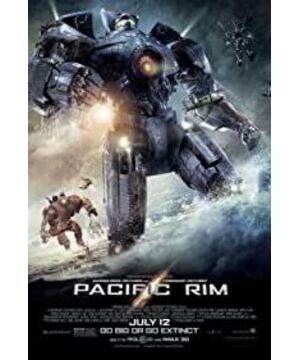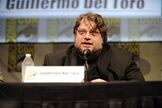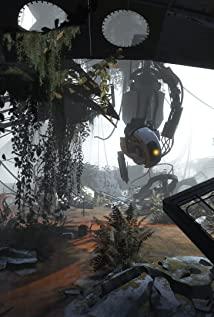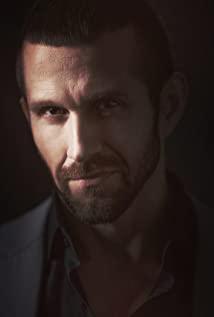Today "Pacific Rim" is released in Japan, I wish it a big hit at home!
As a geek director Gilmour del Toro’s new work "Pacific Rim", in a sense, it can be said to be two major genre treasures in Japanese house culture-the monster film of the special film and the carrot film of animation (ROBO, also Japanese-style robot theme)-a wonderful confluence; of course, it is by no means unilateral, but it is also a historical confluence of Eastern and Western cultures.
In addition to the general audience (bystanders), we tend to divide the audience watching this work into two types of fans and fans. For movie fans, the protagonist is always a human being. This part of the people may neglect all kinds of character creation, such as thinness, facial makeup, etc.; in the eyes of fans, their protagonist is usually an image, a concept, or even simple A kind of emotion, their protagonist can be either a robot or a monster-and for "Pacific Rim", in the eyes of most fans, whether it is a robot or a monster, they are all full marks.
As lovers, they will pay more attention to the reason for their existence, similar to a kind of classical demand, and repeatedly show the passion against the theme melody similar to the prelude of "Orange Perfume" (the creation of this theme is itself a very old school The behavior of commercial films is now, due to the change of editing rhythm, etc., the theme melody has been greatly weakened), they focus on the emotions that are aroused by this, rather than the rationality of their physical existence; in reality, Japan develops giant mechas that can be controlled by mobile phones and Kinect, and Raytheon of the United States recently announced its latest version of Sarcos XOS2 military exoskeleton... However, giant robots like "Pacific Rim" achieve mass production or even simply achieve the possibility of action , Is almost zero, and even those who have good deeds plan to list a hundred reasons to prove that they are not achievable-but it can be regarded as true love to achieve this level.
In addition to the identity of the creator, Gilmour Del Toro, who is also a fan role, can be seen at the end of the "Pacific Rim" feature film for his special effects on the two monster special effects masters: Honda Inshiro and Ray Harryhausen As a tribute, there is also a list of tribute to various radish animation directors (and creators) during the Japanese screening, which is said to be a tribute to various radish animation directors (and creators) at the same time. , Hiroshi Nagai, Ryosuke Takahashi, Yuuki Tomino, Yoshikazu Yasahiko, Hajime Yadate, Mitsuki Yokoyama, Katsuhiro Otomo...
From the plot, the character, to the mechanism, and even the world view, people seem to feel the overwhelming sense of sight everywhere: we see an Asuka-style sexual reversal of the second boy setting, we see a The father-son relationship between Ayanami Rei and Ikari Shinji, we see Hong Kong as the third new shadow of Tokyo... Excluding the EVA stalk most familiar to the public, let’s give an example. We can also try to count and connect with the association and its atmosphere. Some details of the works of the closest real robot animation director Takahashi Ryosuke-
the setting of the time tunnel that Takahashi Ryosuke appears in almost every animation-of course, this itself is actually a Stanley The embodiment of Kubrick enthusiasts; the
inner part may be the continuation of Tomino’s "Ji warrior Den Bein" style setting, and the outer part of the "Mecha World Kalyan" influenced by George Lucas's "Star Wars" series ( The use of swords in Panzer World Galient/Panzer World Galient, 1984)-maybe you can expect to use the Nebula chain-style evolutionary moves in "Pacific Rim 2" instead of "why not use the sword in the first place" ; In
"Fang of the Sun Dogram" (FANG OF THE SUN DOUGRAM / FANG OF THE SUN DOUGRAM, 1981), the robot, which is a symbol of the fight for freedom, is finally blew up by the protagonist (the symbol of destruction by one hand is Takahashi Ryosuke) The usual narrative technique), the ending of "Pacific Rim" is almost the same;
...
Japanese giant robot theme and European and American robot theme can be described as the same and different currents (similar to the monster theme), which inspired and cultivated countless Japan (and further Known to the world) Excellent director:
The cult director Yoshiaki Kawajiri of the violent aesthetic animation admired by European and American fans in the future's directorial debut "SF New Century Lens Man" (SF新世纪レンズマン/Lensman: Secret of The Lens, 1984) Adapted from "Lensman" by American writer Edward Emmer Smith in 1934, the concept of "powered exoskeletons" was originally derived from this work.
Before "Ghost in the Shell" became famous all over the world, it was the mobile police series that got Oshii out of the creative dilemma. In fact, the creative team of "Ghost in the Shell" is actually a re-assembly of mobile police;
but it is almost unknown. Shinichiro Watanabe ("Cowboy Bebop", "Samurai Champloo", etc.), who is said to be a disciple of Takahashi Ryosuke, has grown up step by step through robot animation from his first entry into the animation industry to the first ten years of directing. Ryosuke Takahashi's real robot animation work "Blue Comet SPT Layzner" (Blue Comet SPT Layzner / Blue Comet SPT Layzner, 1985) started from the real robot animation work of Yoshisuke Takahashi, who was the original production job, and involved in all three series of robot animations: The diversity director of Takahashi's armored cavalry series Gaiden "Mecha Hunter" (Armor Hunter Mellowlink/Armor Hunter Mellowlink, 1988), Tomino Yoshiyuki's Gundam series "Mobile Suit Gundam 0083 Memories of Stardust" (mobile The storytelling and diversity director of 0083 STARDUST MEMORY/Mobile Suit GUNDAM0083 STARDUST MEMORY, 1991), and the final director Masaharu Kawamori’s Macross series "Macross Plus" (Macross Plus, 1994).
Both Kawajiri Yoshiaki and Watanabe Shinichiro were animation directors who had participated in the "The Matrix Animation Edition", and Oshii Code rejected the original invitation and felt that participating in the production of this "by-product" was not worth the gain and obliterated the individuality; the Matrix itself borrowed The elements of "Ghost in the Shell" may also be one of the reasons why Oshii entered the project voluntarily-but there are countless examples of Chinese and Western borrowing from each other's creation details. The Hong Kong street scene in "Ghost in the Shell" is nothing more than a copy of "Blade Runner" , And in recent years the "Loop Messenger", the new version of "Total Memories", and the Hong Kong or Hong Kong street scenes in this "Pacific Rim" have all been reproduced time and time again-it's just film fans and animation Fans naturally have two different consciousnesses—"this is a copy of "Silver Wing"" and "this is a copy of "Ghost in the Shell""; for others, this is the atmosphere and the sense of nostalgia.
This can also show that while some people have had their eyes on the defense of Hong Kong, the third new defense of Tokyo, while others will have the defense of Zion in their heads, and others will emerge from the battlefield of Zion. The mecha in the scene is connected to the crane armor in "Alien 2" (Of course, James Cameron introduced mecha changes in the later "Avatar", but if you haven't seen the Alien series, you will be regarded as plagiarism or tribute How about "The Matrix"?)...... Not only is there an inseparable relationship between creation and exploration, as an audience, there is also an inseparable relationship between viewing and exploration, that is, when you know what you love Later, you can discover the origins of the Cthulhu myth from the alien series opened by Ridley Scott, and you can naturally also feel the HP Lovecraft complex from "Pacific Rim"; in general, this is A super vicious circle, and the relationship between them is not a simple inheritance, but rather a process of mutual penetration (transcendental) and mutual enrichment. This is the power of fiction. Just as Borges described in "Circular Ruins", what does not exist will one day become a real existence because of endless descriptions.
"Pacific Rim" itself is probably a product of "Crazy Mountains", such as the opening stars and the seabed, such as the strong sense of sight brought by the spreading wing monster, it is a failure (including the "The Hobbit" Frustrated), but it deliberately or unintentionally opened an idealized template-like giant humanoid robot Hollywood channel; and the director’s own home attributes have made the film not only a carnival of monsters, but also a success. A carnival for card lovers.
Robots, carrots, or mechas are not the home of Del Toro. The monsters are Yiren's home, but compared to the CG monsters that have been seen so much, huge robots have undoubtedly become the next new attraction in Hollywood, the next landscape. As well as money-making tools, especially after Michael Bay’s Transformers series of Hollywood giant humanoid robot CG frenzy, more Hollywood live-action versions of Japanese giant robot animations, including EVA, were put on the agenda.
Compared with Michael Bay, who was born in commercials, who made people famous with sound effects, the achievements of Del Toro's robots in CG light and shadow are undoubtedly like the qualitative change of James Cameron’s Terminator series from freeze to CG, just like Stie Vin Spielberg’s Jurassic Park series brings dinosaurs into Hollywood’s commercial CG from the freeze-frame era of Willis H. O'Brien and Ray Harryhausen The era, no matter from which aspect-especially the creation of a more mature CG special effects production situation-this will be a milestone that will allow film history to enter another latitude of light and shadow.
View more about Pacific Rim reviews











